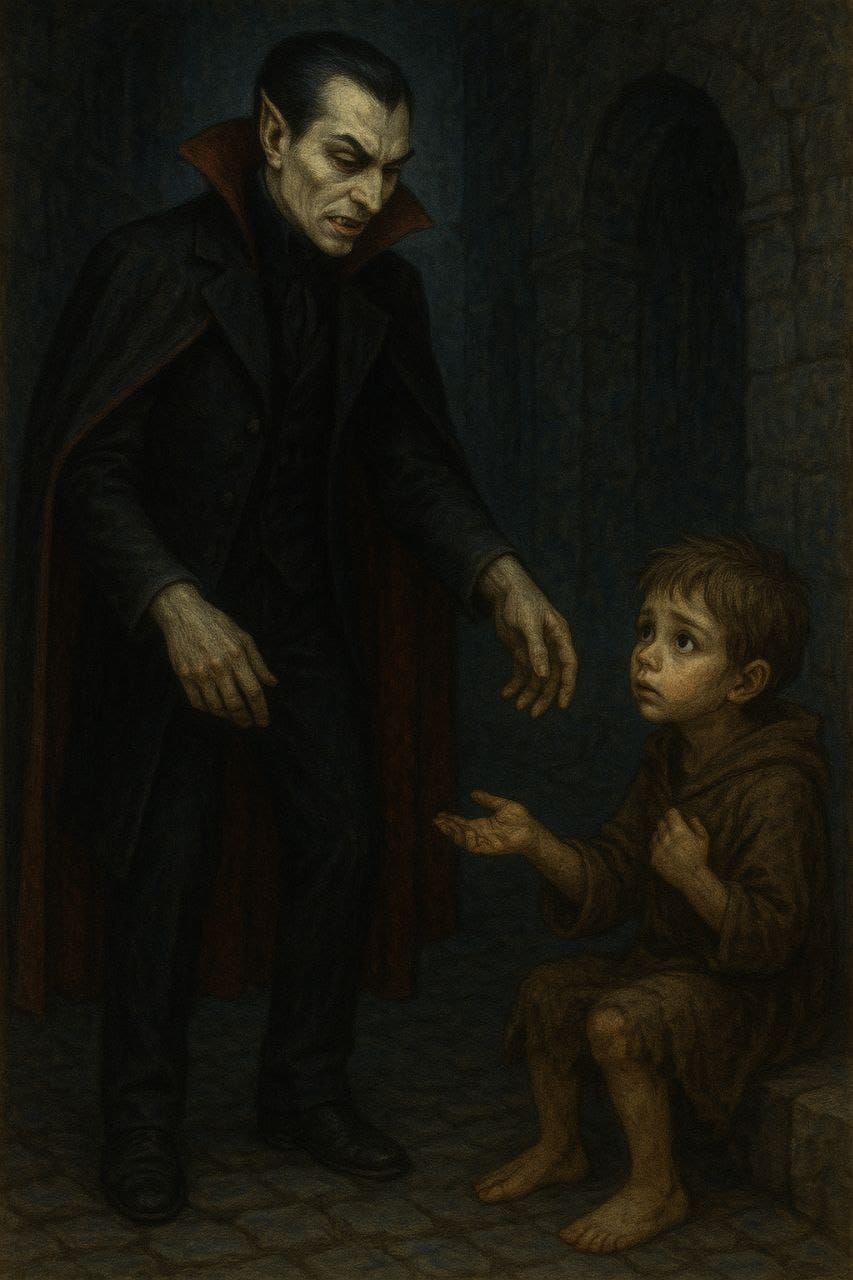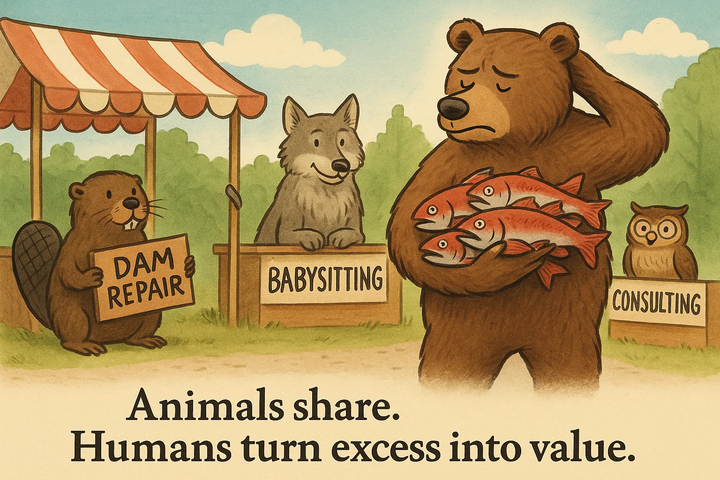Vampire and the Pauper
Scheming with Schelling: The Uncomfortable Math of Our Self-Segregating

The question of how interaction and cohabitation among people from different socioeconomic backgrounds influence social behavior — particularly charitable giving by wealthier groups — has long intrigued researchers across various fields, including sociology, psychology, and philanthropy studies. The central hypothesis is that close and prolonged contact can foster greater awareness, empathy, and, consequently, engagement in addressing the challenges faced by less affluent populations. Below, we examine key arguments and empirical evidence on this topic.
Classic intergroup contact theory (Allport, 1954) suggests that under certain conditions (equal status within the contact situation, shared goals, cooperation, and institutional support), intergroup contact reduces prejudice and fosters more positive attitudes. In the context of charity, this may translate into a greater willingness to help “one’s own” (now perceived as part of a broader community).
Shared living (in a broad sense: neighborhood interactions, work, education, volunteering) provides affluent individuals with direct exposure to the real hardships faced by the less privileged — such as resource scarcity, limited access to quality education or healthcare, and discrimination. This dismantles stereotypes and abstract perceptions (Small, 2017). Personal acquaintances and individual stories make social issues more tangible and emotionally resonant, which motivates action more effectively than abstract statistics (Loewenstein & Small, 2007). Close contact can also foster a deeper understanding of the systemic causes of poverty and inequality, rather than attributing them to personal failures (responsibility attribution). This may shift the focus of charity from direct aid to supporting programs aimed at systemic change (Piff et al., 2010).
In mixed communities, norms of solidarity and mutual support may emerge, integrating wealthier residents as well (Putnam, 2000). Participation in charity thus becomes part of the local culture. Personal connections with activists or members of charitable organizations from other classes can serve as a pathway for affluent individuals to engage in relevant initiatives (McAdam & Paulsen, 1993).
Moreover, contact breaks down “us vs. them” barriers, reducing fear and misunderstanding by incorporating less affluent individuals into one’s social network. Assistance is then perceived as helping acquaintances rather than “distant others.” To use a literary and cinematic analogy, classic vampire stories reflect fears of the aristocracy, while zombie narratives embody anxieties about the lower class. Shared daily life shifts these tropes from Dracula and zombie apocalypses to stories like, forgive the comparison, Twilight and My Zombie Friends.
1. Mixed-income neighborhood studies: research on mixed-income housing policies shows that living alongside people of varying economic statuses can increase awareness of poverty-related issues and foster local mutual aid initiatives, including participation by wealthier residents (Joseph et al., 2007; Tach, 2009). However, results are not always consistent and depend on the quality of interactions.
2. Corporate volunteering and partnerships: programs engaging corporate employees (often more affluent) in joint projects with NGOs serving disadvantaged communities demonstrate increased empathy, understanding of social issues, and willingness to donate (both time and money) among participants (Grant, 2012; Rodell et al., 2016).
3. Educational institutions: studies in universities and schools with diverse socioeconomic compositions indicate that interaction among students from different backgrounds promotes civic engagement and involvement in social projects, including charity (Gurin et al., 2002; Bowman, 2011).
4. Experimental psychology: laboratory experiments confirm that scenarios simulating equal cooperation or personal familiarity with outgroup members increase prosocial behavior, including generosity, toward that group (Dovidio et al., 1997).
Overall, the literature supports the idea that meaningful, equitable, and sustained cohabitation (broadly defined) among people from different socioeconomic classes can be a powerful driver of affluent individuals’ engagement in charity. The primary mechanisms behind this effect are prejudice reduction through contact, increased empathy and awareness of real-world problems, the formation of prosocial norms, and decreased social distance. Empirical data from various contexts (housing, education, corporate volunteering) confirm this link, albeit with caveats.
However, key conditions for positive outcomes include equitable contact, depth and duration of interaction, and shared goals. Superficial or hierarchical interactions may fail to produce the desired effect or even backfire. Additionally, structural barriers (segregation) and differing perceptions of “help” remain significant challenges.
Studying population segregation — the spatial separation of groups by socioeconomic status, race, ethnicity, or other characteristics — is a key task in sociology, urban geography, and economics. Cellular automata (CA) have provided a powerful toolkit for formalizing and investigating the dynamics of this complex social phenomenon. CA models allow researchers to simulate how local interactions between individuals at the micro-level, based on relatively simple rules, can generate stable macroscopic patterns of segregation, often counterintuitive and unexpected. This review focuses on the application of CA to study the mechanisms and consequences of spatial segregation.
Basic Principles of Modeling Segregation Using CA

The territory (city, district) is discretized into cells of a regular grid (most commonly square). Each cell can be in one of two states: empty or occupied by an agent of a certain type (e.g., Class A, Class B, Ethnicity 1, Ethnicity 2). Agents (residents) have a key characteristic — tolerance or discontent threshold. This is the minimum proportion of neighbors of their own type (or, less commonly, other types) required for an agent to feel comfortable in their current cell. For example, an agent may be content if at least 30% of their neighbors are similar to them. An agent evaluates satisfaction with their current location based on the composition of their neighbors (typically within a defined neighborhood, e.g., Moore or von Neumann neighborhood) and their tolerance threshold.
If the agent is dissatisfied (the proportion of “similar” neighbors is below their threshold), they attempt to move to a randomly selected empty cell. At the new cell, they reassess satisfaction. The process repeats until stability is reached or a set number of iterations is completed.
The system evolves in discrete steps (generation by generation). At each step, all dissatisfied agents (or a random subset) attempt to relocate. The overall system behavior depends on the distribution of tolerance thresholds among agents and the initial configuration of settlement.
The Classic Model: Schelling’s Paradox (Schelling, 1971, 1978)
Thomas Schelling used a concept analogous to CA (though not formally named as such) to demonstrate his famous “paradox” or “segregation model.” Even when agents have very moderate preferences to live near some neighbors like themselves (e.g., a threshold of just 30%), the system inevitably evolves toward high global segregation, far exceeding individuals’ initial preferences. Minor dissatisfaction triggers relocations. The movement of one agent alters the local environment for their old and new neighbors, potentially making them dissatisfied and setting off a chain reaction. This creates a self-reinforcing clustering process. Schelling’s model showed that large-scale segregation can be an unintended consequence of individual actions, rather than a result of strong prejudice or centralized policy. This was a fundamental contribution to understanding emergent social phenomena.
Modern Modifications and Extensions of CA Models for Segregation:
- Multi-Group Models: moving beyond binary segregation (Type A / Type B). Simulating interactions among three or more groups with different tolerance thresholds (Zhang, 2004; Grauwin et al., 2012). Reveals complex patterns: enclaves, “buffer zones,” minority displacement.
- Agent Heterogeneity: agents have individual (not uniform) tolerance thresholds (e.g., normally distributed). Preferences may concern not just the share of “similar” neighbors but also the share of “different” or specific groups (Fossett, 2006).
- Economic factors: introducing housing costs, income levels, and mobility constraints. Agents choose based on affordability, not just neighbors (Benenson et al., 2002). Allows modeling gentrification, displacement.
- Spatial Structure: using graphs (networks) to represent connections between cells, better reflecting real urban layouts (streets, transport. Influence not just immediate neighbors but also broader surroundings (different radii), incorporating real geographic features (rivers, parks, industrial zones) as barriers or catalysts for segregation.
- Dynamic Parameters:agents’ tolerance levels may change over time based on experience and environment (Flache & Hegselmann, 2001), simulating natural population growth/decline and external migration can be done.
- Modeling the impact of desegregation policies: quotas, subsidies, taxes: Incentivizing mixed neighborhoods or penalizing segregated ones.Models help assess effectiveness and unintended consequences of such policies (Pancs & Vriend, 2007).
Key Insights from CA Models
CA vividly demonstrate how global segregation arises from decentralized local decisions, highlighting self-organization. High segregation does not require strong hostility; even mild in-group preferences suffice (Schelling’s Paradox). Final segregation levels heavily depend on initial conditions (degree of initial mixing) and randomness in relocation processes. Systems may get “stuck” in segregated states. Once formed, segregated patterns are often highly persistent. Disrupting them requires major interventions or shifts in majority preference. Critical parameter values (average tolerance, vacancy rates) exist where systems abruptly shift from mixed to segregated states (or vice versa).
Criticisms and Limitations of CA Models
While cellular automata (CA) models have provided valuable insights into segregation dynamics, they face several fundamental limitations that stem from their inherent simplifications of complex social realities. The most significant constraint lies in their oversimplified representation of human decision-making. Real-world residential choices involve a multifaceted calculus that extends far beyond immediate neighborhood composition. Economic constraints, family considerations, cultural values, long-term life plans, and city-wide information networks all play crucial roles that standard CA frameworks fail to incorporate. This schematic treatment of agent behavior creates a substantial gap between model dynamics and actual human mobility patterns.
Equally problematic is the assumption of static preferences in traditional CA models. In reality, tolerance thresholds and residential preferences evolve dynamically, shaped by personal experiences, media influences, ideological shifts, and changing social contexts. The fixed parameters used in most simulations cannot capture this adaptive nature of human attitudes, potentially leading to overly deterministic projections. The models’ abstract spatial representation presents another major limitation. Real urban landscapes feature complex morphologies with transportation barriers, natural terrain features, and varying neighborhood desirability — all factors poorly approximated by uniform grid structures.
Perhaps most critically, CA models typically focus narrowly on individual choice mechanisms while neglecting powerful institutional forces that shape housing markets. Historical patterns of discrimination like redlining, contemporary zoning laws, realtor practices, and structural economic inequalities all exert profound influences on segregation patterns that cannot emerge from purely agent-driven simulations. These systemic factors often create path dependencies and structural constraints that individual preferences alone cannot explain.
The models also face substantial empirical challenges in calibration and validation. Determining appropriate parameter values for tolerance thresholds that accurately reflect real populations remains problematic, while the lack of clear validation protocols raises questions about the models’ predictive power. Furthermore, the sensitivity of results to stochastic elements — such as the order in which agents evaluate their satisfaction or select new locations — introduces additional uncertainty in interpreting outcomes. These methodological hurdles limit the models’ utility for precise policy analysis or forecasting in specific urban contexts.
These limitations collectively suggest that while CA models excel at illustrating fundamental mechanisms of segregation emergence, their simplified frameworks require careful interpretation and supplementation with other analytical approaches to fully capture the complexity of real-world residential dynamics. The models’ strength lies in demonstrating potential structural patterns rather than predicting actual segregation outcomes, which are shaped by a far richer set of social, economic, and institutional factors than current CA frameworks can incorporate.
A moment of reflection
Ah, this elegant nightmare of Schelling! Here it is, the naked skeleton of our hypocrisy, wrapped in mathematical lace. Look how beautifully our rotten essence is exposed! We, the enlightened, the liberal, with tolerance in our manifestos and flags of progress on our balconies. We swear our love for diversity, give discounts on political correctness and build glass bridges between worlds. “That’s all!” we exclaim. “I just want thirty percent of mine at the front door! Not rabble, not cattle, but simply… familiar faces. A modest right to comfort!”
And here he is, the genius of Schelling, this cold doorman of social hell! He takes our modest thirty percent — not fascism, not apartheid, just a slight preference! — and throws it into the mouth of the algorithm. And what happens? The city turns into a zoo of castes. The rich quarters are besieged fortresses of marble and fear. The poor areas are the reservations of despair. And between them is a wall. Invisible, but stronger than the one in Berlin. A wall of our noble thirty percent!
Oh, we don’t want segregation! We hate it in slogans! But in the silence of our souls, in subconscious trepidation, we whisper: “Just not right next door. Not in my building. Not behind my wall.” And this whisper is enough. Schelling’s algorithm is a devilish mirror reflecting our ineradicable cowardice. We are not racists, oh no! We just… want to sleep peacefully. Not to see someone else’s misfortune from the kitchen window. Not to hear someone else’s music through a thin wall. Not to know.
Segregation is not an order from a tyrant. It is our collective sin. The sin of cowardice, disguised as the right to choose. We build ghettos not with laws, but with millions of micro-betrayals. Millions of “logical” decisions to move to a “quieter area.” Millions of sighs of relief when the “different” ones themselves leave our space. Schelling showed us the mechanism of our own baseness. Mathematically flawless. Inexorable.
Paris burned for a reason. These suburbs are the product of our thirty percent barrier. Our polite segregation by postcode, by school for children, by golf club. We sow the wind of micro-prejudices — and reap a hurricane of hatred. We shout about solidarity, but run from a neighbor in a shabby jacket. We sponsor charity galas, but shudder at the thought of social housing in our neighborhood.
Schelling’s paradox is not a theory. It is a diagnosis. A cadaverous diagnosis of our society. We are decaying from within — not from external enemies, but from our own, polite egoism. From fear of the Other, seasoned with hypocritical rhetoric about diversity. We want diversity somewhere out there, at a safe distance, on TV or at an ethnic food festival. But not in our home. Never in our home.
And as long as we cling to these damned “30% comfort” — our cities will remain divided. Ghettos — physical and mental — will grow. And we, the “enlightened”, will console ourselves with the fact that we are “not guilty”. After all, we only wanted “a little of our own”… Schelling showed us the hell that we are building with our own hands. And the worst thing is that we are building it sincerely believing that we are doing the right thing. Here it is — the mortal sin of the modern liberal. Not malice. Cowardice. Noble, refined, mathematically inevitable cowardice.
References
Schelling, T. C. (1971, 1978) — Foundational work.
Zhang, J. (2004) — Multi-group segregation.
Fossett, M. (2006) — Ethnic preference dynamics.
Benenson et al. (2002) — Economic factors in urban models.
Pancs & Vriend (2007) — Policy evaluation.
Flache & Hegselmann (2001) — Dynamic thresholds.
Grauwin et al. (2012) — Analytical solutions for segregation.
Allport, G. W. (1954). The nature of prejudice. Addison-Wesley.
Bowman, N. A. (2011). Promoting participation in a diverse democracy: A meta-analysis of college diversity experiences and civic engagement. Review of Educational Research, 81(1), 29–68.
Dixon, J., Durrheim, K., & Tredoux, C. (2005). Beyond the optimal contact strategy: A reality check for the contact hypothesis. American Psychologist, 60(7), 697.
Dovidio, J. F., Gaertner, S. L., Validzic, A., Matoka, K., Johnson, B., & Frazier, S. (1997). Extending the benefits of recategorization: Evaluations, self-disclosure, and helping. Journal of Experimental Social Psychology, 33(4), 401–420.
Grant, A. M. (2012). Giving time, time after time: Work design and sustained employee participation in corporate volunteering. Academy of Management Review, 37(4), 589–615.
Gurin, P., Dey, E. L., Hurtado, S., & Gurin, G. (2002). Diversity and higher education: Theory and impact on educational outcomes. Harvard Educational Review, 72(3), 330–367.
Joseph, M. L., Chaskin, R. J., & Webber, H. S. (2007). The theoretical basis for addressing poverty through mixed-income development. Urban Affairs Review, 42(3), 369–409.
Loewenstein, G., & Small, D. A. (2007). The scarecrow and the tin man: The vicissitudes of human sympathy and caring. Review of General Psychology, 11(2), 112.
McAdam, D., & Paulsen, R. (1993). Specifying the relationship between social ties and activism. American Journal of Sociology, 99(3), 640–667.
Piff, P. K., Kraus, M. W., Côté, S., Cheng, B. H., & Keltner, D. (2010). Having less, giving more: The influence of social class on prosocial behavior. Journal of Personality and Social Psychology, 99(5), 771.
Putnam, R. D. (2000). Bowling alone: The collapse and revival of American community. Simon and Schuster.
Reardon, S. F., & Bischoff, K. (2011). Income inequality and income segregation. American Journal of Sociology, 116(4), 1092–1153.
Rodell, J. B., Breitsohl, H., Schröder, M., & Keating, D. J. (2016). Employee volunteering: A review and framework for future research. Journal of Management, 42(1), 55–84.
Small, M. L. (2017). Someone to talk to. Oxford University Press.
Tach, L. M. (2009). More than bricks and mortar: Neighborhood frames, social processes, and the mixed-income redevelopment of a public housing project. City & Community, 8(3), 269–299.



Comments ()